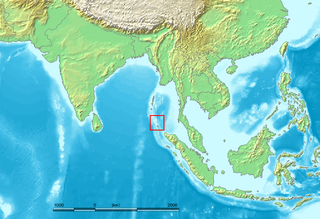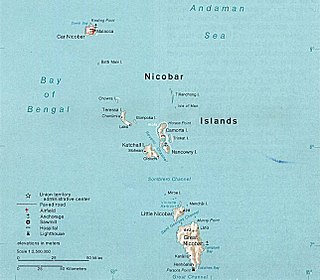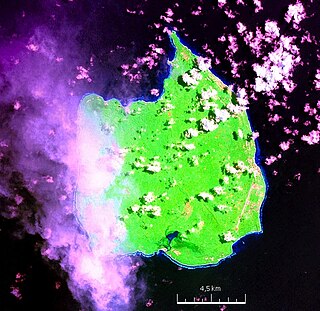
The Nicobar Islands are an archipelagic island chain in the eastern Indian Ocean. They are located in Southeast Asia, 150 kilometres (93 mi) northwest of Aceh on Sumatra, and separated from Thailand to the east by the Andaman Sea. Located 1,300 kilometres (810 mi) southeast of the Indian subcontinent, across the Bay of Bengal, they are part of India, as the Nicobar district within the union territory of the Andaman and Nicobar Islands.

The Nicobarese languages or Nicobaric languages, form an isolated group of about half a dozen closely related Austroasiatic languages, spoken by most of the inhabitants of the Nicobar Islands of India. They have a total of about 30,000 speakers. Most Nicobarese speakers speak the Car language. Paul Sidwell (2015:179) considers the Nicobarese languages to subgroup with Aslian.

According to official estimates in India, 10,749 people were killed, 5,640 people were missing and thousands of people became homeless when a tsunami triggered by the 2004 Indian Ocean earthquake near the Indonesian island of Sumatra struck the southern coast on 26 December 2004. The earthquake registered 9.1–9.3 Mw and was the largest in five decades. It was followed by strong aftershocks on the Andaman and Nicobar Islands. The death toll of the earthquake was 1,500 people.

Car Nicobar is the northernmost of the Nicobar Islands. It is also one of three local administrative divisions of the Indian district of Nicobar, part of the Indian union territory of Andaman and Nicobar Islands. Annual rainfall is 2800 millimetres.
Nancowry is an island in the central part of the Nicobar Islands chain, located in the northeast Indian Ocean between the Bay of Bengal and the Andaman Sea.
Trinket Island is one of the 24 islands that make up the Nicobar Islands chain, located in the northeast Indian Ocean between the Bay of Bengal and the Andaman Sea. It is located east of Kamorta Island.

The Shompen or Shom Pen are the indigenous people of the interior of Great Nicobar Island, part of the Indian union territory of Andaman and Nicobar Islands.

The Nicobar Islands rain forests is a tropical moist broadleaf forest ecoregion in the Nicobar Islands, which is part of the Andaman and Nicobar Islands union territory of India. The Nicobar Islands are in the Indian Ocean, lying north of Sumatra and south of the Andaman Islands. The islands are politically part of India, although physically closer to Southeast Asia. Millions of years of isolation from the mainland has given rise to a distinct flora and fauna, including many endemic species.
Nicobar district is one of three districts in the Indian union territory of the Andaman and Nicobar Islands. The district's administrative territory encompasses all of the Nicobar Islands, which are located in the Indian Ocean, between the Bay of Bengal and the Andaman Sea. The headquarters of the district is the village of Malacca, located on the island of Car Nicobar.
Teressa is one of the Nicobar Islands, India.
Shompen, or Shom Peng is a language or group of languages spoken on Great Nicobar Island in the Indian union territory of the Andaman and Nicobar Islands, in the Indian Ocean, northwest of Sumatra, Indonesia.
Teressa, or Taih-Long is one of the Nicobarese languages spoken on the Teressa Island of Nicobar Islands in India. Bompoka dialect (Pauhut) is distinct. As of 2001, there are 2,080 speakers.
Southern Nicobarese is a Nicobarese language, spoken on the Southern Nicobar Islands of Little Nicobar (Ong), Great Nicobar (Lo'ong), and a couple small neighboring islands, Kondul (Lamongshe) and Pulo Milo. Each is said to have its own dialect.
Nancowry is a Nicobarese language spoken on the Nancowry Island in the central Nicobar Islands. It is not mutually intelligible with the other Central Nicobarese languages, and is distantly related to Vietnamese and Khmer.
Katchal, or Tehnu (Tēhnyu), is a Nicobarese language spoken in the central Nicobar Islands. Apart from the dialect of Trinket, it is not mutually intelligible with the other Central Nicobarese languages. The population of Trinket was evacuated to Nancowry and Camorta after the 2004 tsunami, and can be expected to disappear as speakers assimilate.
Tillangchong, also known as Tillanchang, is an island and a village in the Nicobar district of Andaman and Nicobar Islands, India.
Hintona is a village in the Nicobar district of Andaman and Nicobar Islands, India. It is located in the Nancowry tehsil.
Bompuka Island, also known as Poahat, is an island of India, in the Andaman and Nicobar Islands.

John Richardson was an Indian Anglican bishop and politician.

Frederik Adolph de Roepstorff was a Danish philologist who worked in the Andaman penal colony in India, where he was shot dead by a convict. He studied the languages of Andaman and Nicobar tribes and collected numerous natural history specimens. The Andaman masked owl was named after him by Hume.









